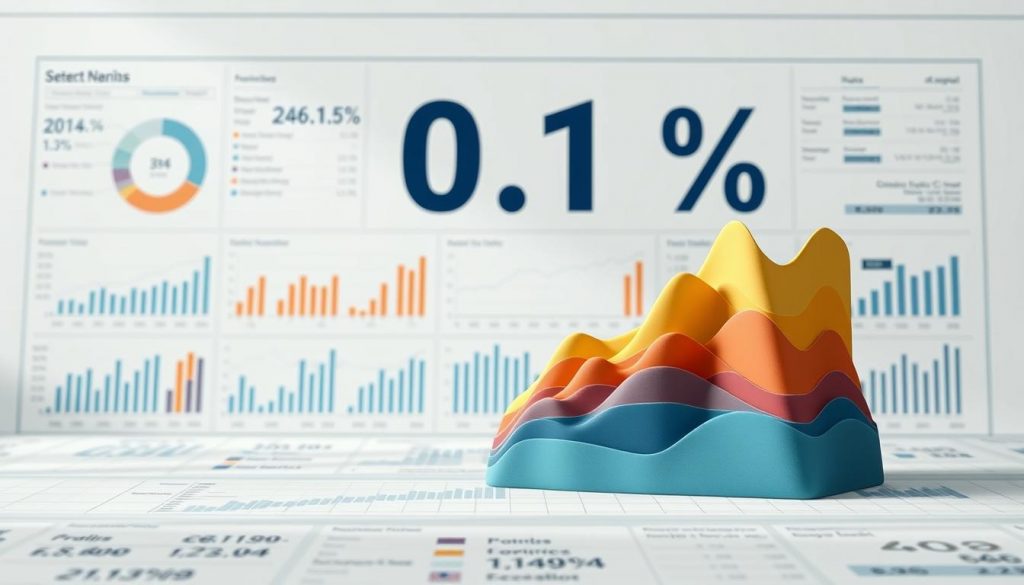Is a modest economic expansion truly a sign of recovery, or does it mask deeper underlying challenges? This question lingers as new growth figures emerge.
Official data reveals a 0.1% expansion during August, following a revised contraction the previous month. This slight uptick offers a glimmer of hope after recent struggles.
Over three months, the economy showed a 0.3% growth rate, indicating steady but fragile momentum. Chancellor Rachel Reeves expressed relief at these developments.
Beyond the headlines, however, lies a complex story of sectoral performances and global influences. Understanding these nuances is crucial for businesses and policymakers alike.
This analysis explores what these numbers truly signify for the nation’s economic trajectory and future policy decisions.
Key Takeaways
- The economy experienced modest growth of 0.1% in August after previous contraction
- Three-month figures show a 0.3% expansion, suggesting gradual recovery
- Government officials have expressed cautious optimism about these developments
- Sectoral performances vary significantly beneath the headline growth figure
- Global economic factors continue to influence domestic performance
- Understanding these nuances is essential for informed business decisions
- The data suggests fragile momentum rather than robust recovery
UK GDP Registers 0.1% Growth in August Amid Economic Crosscurrents
The latest economic indicators present a complex picture of cautious recovery battling persistent headwinds. While the headline figures show modest improvement, deeper analysis reveals significant challenges across different sectors.
ONS Data Reveals Modest Rebound from Revised July Contraction
Office for National Statistics figures confirm a 0.1% expansion during August. This follows a revised 0.1% contraction in the previous month.
The rebound suggests some resilience despite ongoing pressures. However, economists describe the recovery as fragile rather than robust.
Three-Month Growth Holds Steady at 0.3%
Over the three months to August, the economy expanded by 0.3%. This steady momentum indicates gradual rather than rapid improvement.
Consumer-facing services declined by 0.6% during this period. This weakness highlights ongoing struggles in key sectors.
Chancellor’s Relief Tempered by Underlying Economic Challenges
Chancellor Rachel Reeves welcomed the growth news but acknowledged significant hurdles. “While we welcome any positive movement, we cannot ignore the underlying pressures facing households and businesses,” she stated.
The Treasury faces difficult decisions in the upcoming autumn budget. A fiscal gap estimated between £20 billion and £30 billion requires careful management.
Bank of England policy remains restrictive with high interest rates. Most analysts anticipate rate cuts only in 2026, maintaining pressure on borrowing costs.
Inflationary pressures continue affecting consumer confidence and spending. Many families still struggle with the cost of living despite recent improvements.
Global economic uncertainty adds another layer of complexity. Trade patterns and international demand influence domestic production and investment decisions.
Business leaders express cautious optimism but want clearer signals from the government. The autumn budget’s approach to tax rises and spending cuts will significantly impact market confidence.
This interplay between modest growth and underlying challenges sets the stage for deeper sectoral analysis. Understanding these dynamics is crucial for anticipating future economic trajectories.
The Anatomy of 0.1%: A Sectoral Deep Dive into UK Economic Performance
The 0.1% growth figure conceals significant disparities across different industries, revealing both strengths and vulnerabilities. This sectoral analysis provides crucial insights into the underlying dynamics driving the modest expansion.

Manufacturing emerged as a bright spot with robust performance in specific areas. Meanwhile, other sectors faced persistent challenges that tempered overall economic momentum.
UK GDP Up 0.1% in August: What It Means for the Economy
Manufacturing Resurgence Offsets Stagnant Services Sector
Manufacturing output grew by 0.7% during August, reversing July’s 1.1% decline. Pharmaceutical production drove much of this recovery, demonstrating sector resilience.
The pharmaceutical industry’s strong performance offset weaknesses elsewhere. This suggests specialised manufacturing can thrive despite broader economic pressures.
Industrial output patterns show selective strength rather than widespread recovery. Businesses in specific manufacturing niches continue to adapt successfully.
Check out our recent review of how the UK Economy Beats the Odds in our full article here
Construction Output Declines Amid Pre-Budget Uncertainty
Construction activity declined by 0.3% as uncertainty affected investment decisions. Deutsche Bank analysts noted a “pre-budget funk” influencing sector performance.
Repairs and maintenance work particularly suffered during this period. Many businesses delayed projects awaiting clarity on potential tax rises.
The autumn budget’s approach will significantly impact the construction sector recovery. Market confidence remains fragile until government policy becomes clearer.
Consumer-Facing Services Struggle as Business Rental Booms
Services sector activity remained flat for the second consecutive month. Consumer-facing areas like retail and leisure experienced particular weakness.
In contrast, business rental and leasing surged by 5.3% during August. This indicates corporate adaptability despite economic uncertainty.
The divergence highlights different spending patterns between consumers and businesses. While households remain cautious, companies continue investing in operational flexibility.
Trade Deficit Widens on Falling Exports to EU and US
The trade deficit widened to £5.2 billion as exports declined significantly. Reduced shipments to key markets contributed to this deterioration.
Exports to European Union nations fell by 5.3%, representing an £800 million decrease. United States exports also declined by £700 million during the period.
Office for National Statistics data attributes this to reduced machinery and chemical shipments. Specific issues included fewer aircraft and pharmaceutical exports to Germany.
These export challenges highlight ongoing trade relationship complexities. Global economic conditions continue to influence domestic production decisions.
| Sector | August Performance | Key Drivers | Outlook |
|---|---|---|---|
| Manufacturing | +0.7% growth | Pharmaceutical production surge | Selective strength continuing |
| Services | 0.0% change | Consumer weakness vs business resilience | Mixed recovery expected |
| Construction | -0.3% decline | Pre-budget uncertainty | Budget-dependent recovery |
| Business Services | +5.3% rental growth | Corporate adaptability | Continued strength likely |
| International Trade | £5.2bn deficit | Reduced EU and US exports | Global conditions dependent |
Sectoral performances reveal an economy experiencing selective growth rather than a broad-based recovery. The manufacturing rebound provided a crucial offset to weaknesses elsewhere.
Business services demonstrated remarkable resilience through rental and leasing activity. This suggests corporate adaptation strategies are proving effective.
However, consumer-facing sectors and construction face ongoing challenges. These areas require sustained policy support and improvements in market confidence.
The mixed performance across sectors underscores the fragile nature of current economic momentum. Sustainable growth will require broader sectoral participation rather than relying on niche strengths.
Recent economic analysis suggests similar sectoral patterns emerged in previous quarters, indicating these trends may persist without intervention.
Economic Outlook: Inflation, Interest Rates, and Policy Responses
Looking beyond immediate figures reveals a complex interplay between monetary policy and economic momentum. The nation’s financial trajectory depends on careful balancing of competing priorities.
Policymakers face difficult choices between controlling price rises and supporting business activity. This delicate dance will shape economic performance throughout the coming year.

Bank of England’s Monetary Policy Dilemma
The central bank maintains a restrictive stance with high borrowing costs. Most analysts anticipate interest rate cuts only in 2026.
This prolonged period of elevated rates creates significant pressure on business investment. Companies delay capital expenditure amid uncertainty about future financing costs.
Economists describe the policy dilemma as particularly challenging. “The Bank must navigate between inflation control and growth support with limited tools,” noted one leading analyst.
Inflationary Pressures and the Cost of Living Crisis
Household finances remain under strain despite recent improvements. Many families continue adjusting spending behaviors due to persistent cost pressures.
Consumer confidence shows only ga radual recovery from recent lows. This affects demand across various sectors of the economy.
The services sector experiences particular challenges from reduced discretionary spending. Retail and leisure activities face ongoing headwinds.
Assessing the Risks of Economic Slowdown Versus Resilience
Global trade tensions add another layer of complexity to domestic performance. Export markets show mixed signals that influence production decisions.
Manufacturing demonstrates remarkable resilience in certain niche areas. However, broader industrial activity faces uncertainty about future demand.
The International Monetary Fund offers grounds for cautious optimism. Its forecasts position the nation as the second-fastest-growing G7 economy in 2025.
Autumn Budget Looms Large Over Business and Consumer Confidence
Chancellor Rachel Reeves faces critical decisions about fiscal policy. The autumn budget on 26 November may include tax rises to address fiscal challenges.
Business leaders express concern about potential impacts on investment and growth. Many companies have already adopted strategies through rental options rather than capital expenditure.
The Treasury acknowledges economic stagnation concerns while planning growth initiatives. Infrastructure investment and regulatory simplification feature prominently in policy discussions.
| Policy Area | Current Status | Expected Changes | Potential Impact |
|---|---|---|---|
| Interest Rates | Restrictive stance maintained | Cuts expected in 2026 | Continued pressure on borrowing |
| Inflation Control | Gradual easing observed | Further moderation expected | Improved consumer confidence |
| Fiscal Policy | Pre-budget uncertainty | Potential tax rises | Business investment decisions |
| Growth Support | Selective sector strength | Infrastructure focus | Long-term momentum building |
| International Position | Mixed trade performance | IMF growth optimism | Enhanced market confidence |
The economic outlook remains finely balanced between challenges and opportunities. Policy responses must carefully consider both immediate pressures and long-term objectives.
Sustainable growth requires a coordinated approach across monetary and fiscal measures. Businesses and consumers alike await clearer signals about future direction.
While current GDP figures show modest improvement, underlying momentum remains fragile. The coming months will prove crucial for determining whether this represents genuine recovery or temporary respite.
Conclusion: UK GDP Up 0.1% in August: What It Means for the Economy
Key Takeaways for Businesses and Consumers Navigating the Economic Landscape
The path forward demands thoughtful consideration of both opportunities and challenges. Current economic momentum remains fragile despite modest expansion.
Businesses should focus on flexibility and monitor budget developments closely. Adapting strategies to sectoral trends proves essential for sustained growth.
Consumers face continued cost pressures requiring careful budgeting. Staying informed about interest rate changes helps with financial planning.
Manufacturing and business services show resilience worth leveraging. The autumn budget’s potential tax rises warrant preparedness.
Economic data suggests a gradual improvement ahead, with projected growth of 1.4% next year. Staying engaged with official updates enables better positioning.


